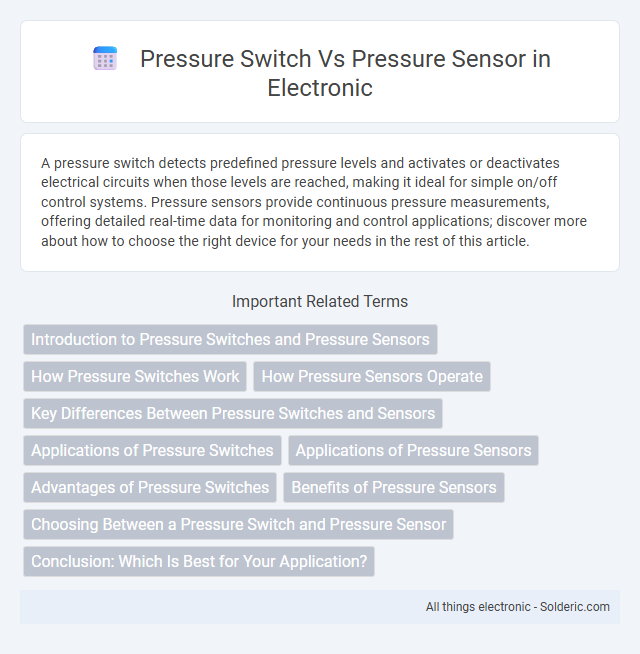A pressure switch detects predefined pressure levels and activates or deactivates electrical circuits when those levels are reached, making it ideal for simple on/off control systems. Pressure sensors provide continuous pressure measurements, offering detailed real-time data for monitoring and control applications; discover more about how to choose the right device for your needs in the rest of this article.
Comparison Table
| Feature | Pressure Switch | Pressure Sensor |
|---|---|---|
| Function | Activates/deactivates a circuit at set pressure | Measures pressure and provides continuous signal output |
| Output Type | Digital (on/off) | Analog or digital (variable signal) |
| Accuracy | Moderate, suitable for threshold detection | High, precise pressure measurement |
| Applications | Overpressure protection, control systems | Process monitoring, data logging, control feedback |
| Cost | Generally low cost | Typically higher cost |
| Complexity | Simple design, easy integration | More complex, requires calibration and signal processing |
| Response Time | Fast switching at set point | Continuous real-time response |
Introduction to Pressure Switches and Pressure Sensors
Pressure switches and pressure sensors both monitor fluid or gas pressure but serve different functions in industrial applications. Pressure switches are designed to trigger an electrical contact when a preset pressure threshold is reached, enabling control systems to activate or deactivate equipment. Pressure sensors, by contrast, continuously measure pressure levels and convert them into analog or digital signals for precise monitoring and data analysis.
How Pressure Switches Work
Pressure switches operate by detecting fluid or gas pressure levels in a system and triggering an electrical contact when a preset threshold is reached. These devices use mechanical components such as diaphragms, pistons, or bellows that deform under pressure, activating the switch to open or close an electrical circuit. Your system relies on pressure switches for safety and control, as they provide reliable on/off signals without continuous pressure measurement.
How Pressure Sensors Operate
Pressure sensors operate by converting physical pressure into an electrical signal through various sensing elements such as piezoelectric, capacitive, or strain gauge technology. This signal can be continuously monitored and processed, enabling precise measurement and control of fluid or gas pressure in diverse applications. Understanding how your pressure sensor functions helps ensure accurate performance and reliable pressure monitoring in your systems.
Key Differences Between Pressure Switches and Sensors
Pressure switches and pressure sensors differ primarily in functionality; pressure switches provide a binary output indicating whether pressure has reached a set threshold, while pressure sensors offer continuous, real-time pressure readings with precise measurement data. Pressure switches are typically used for control applications such as activating alarms or machinery at specific pressure points, whereas pressure sensors are essential for monitoring and data analysis in complex systems requiring detailed pressure profiles. The choice between the two depends on the application's need for simple on/off control versus detailed pressure measurement and monitoring.
Applications of Pressure Switches
Pressure switches are widely used in industrial automation, HVAC systems, and fluid control applications where precise activation of equipment at specific pressure levels is critical. They serve essential roles in safety systems, such as preventing overpressure in pumps and compressors, and in monitoring systems to trigger alarms or control circuits. Your choice of a pressure switch ensures reliable operation in on/off control scenarios, contrasting with pressure sensors that provide continuous pressure measurement data.
Applications of Pressure Sensors
Pressure sensors are widely used in automotive systems for monitoring tire pressure and engine performance, ensuring safety and efficiency. In industrial automation, they provide precise data for controlling hydraulic and pneumatic systems, optimizing process control and maintenance. Medical devices rely on pressure sensors to measure blood pressure and respiratory parameters, enhancing patient monitoring and diagnostics.
Advantages of Pressure Switches
Pressure switches offer reliable and straightforward operation by providing binary on/off signals based on preset pressure thresholds, making them ideal for safety and control applications. Their durability and cost-effectiveness ensure long-term performance in harsh environments without the need for complex calibration or continuous monitoring. You benefit from easy integration and immediate system responses, enhancing operational efficiency and preventing costly equipment damage.
Benefits of Pressure Sensors
Pressure sensors provide continuous and precise monitoring of pressure levels, enabling real-time data analysis crucial for advanced automation and process control systems. They offer enhanced sensitivity and accuracy compared to pressure switches, allowing detection of minor fluctuations that improve equipment safety and efficiency. Integration capabilities with digital systems make pressure sensors ideal for applications requiring detailed diagnostics and predictive maintenance.
Choosing Between a Pressure Switch and Pressure Sensor
Choosing between a pressure switch and a pressure sensor depends on the specific requirements of your application, such as whether you need simple on/off control or continuous pressure monitoring. Pressure switches activate or deactivate circuits based on preset pressure thresholds, making them ideal for alarms or safety systems, while pressure sensors provide detailed analog or digital pressure data for precise measurement and control. Consider factors like response time, accuracy, output type, and system complexity to determine which device best suits your operational needs.
Conclusion: Which Is Best for Your Application?
Pressure switches are ideal for applications requiring simple on/off control at specific pressure points, providing reliable, cost-effective switching without continuous monitoring. Pressure sensors offer precise, real-time pressure measurements and greater versatility for complex systems demanding data analysis and automation. Your choice depends on the need for either basic threshold detection or detailed pressure monitoring and control.
pressure switch vs pressure sensor Infographic

 solderic.com
solderic.com